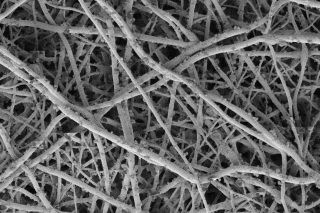Methicillin-resistant Staphylococcus aureus (MRSA), a type of staph bacteria, resists treatment with several antibiotics. Staph and MRSA can cause problems ranging from skin infections to sepsis to pneumonia to bloodstream infections.
If left untreated, MRSA infections can worsen and cause sepsis, which is a life-threatening reaction to severe infection in the body. In healthcare settings such as hospitals and nursing homes MRSA can cause severe problems such as bloodstream infections, pneumonia and surgical site infections.
The incidence of MRSA
is rising, limiting the treatment options for physicians and surgeons.
But, a new type of biomaterials created to hold stem cells may aid healthcare providers in their fight against the worrisome infection in patients.
Developed by an international team of researchers, the biomaterials are silver ion-coated scaffolds that not only slow the spread of or kill MRSA, but also regenerate new bone.
Elizabeth Loboa, Dean of the University of Missouri College of Engineering, says, "Increasingly, those in the healthcare profession are running out of choices when it comes to treating MRSA while regenerating tissue. Using previously reported scaffolds that were created in our lab, we set out to determine the efficacy of coating these structures with silver ions and whether they were useful in treating or preventing osteomyelitis."
She cites osteomyelitis as one of the debilitation infections MRSA causes. Osteomyelitis is an infection of the bone and bone marrow that can destroy the bone and cause deformity or result in amputation if untreated. MRSA osteomyelitis occurs when the pathogen causing the infection to the bone is identified as MRSA.
She and her team created the scaffolds from polylactic acid (PLA), an FDA-approved polymer that biodegrades in the body. The researchers then applied a silver-ion releasing coating to the scaffolds and "seeded" them with fat-derived adult stem cells that could be "triggered" to create bone cells.
The scaffolds were seeded with MRSA so the researches could observe whether or not silver ions could fight the bacteria. They found the silver ion-releasing scaffolds inhibited MRSA while also supporting bone tissue formation.
"Silver is well known for its antimicrobial properties and is highly toxic to a wide range of microorganisms such as MRSA," Loboa says. "Silver ions work mechanically—they actually disrupt the cellular machinery of MRSA. Our research now has shown that bone tissues still can be formed even in the presence of MRSA."
Loboa adds that her team has created the materials needed for bone tissue engineering that will allow patients to use their own fat cells to create patient-specific bone and surgically implant those cells and tissues while diminishing, or potentially eliminating, the risk of MRSA infection.
The early-stage results of this research are promising. If additional studies are successful within the next few years, university officials could request authority from the federal government to begin human device development.
If the request is granted, the researchers can conduct human clinical trials with the hope of developing new treatments for osteomyelitis.




